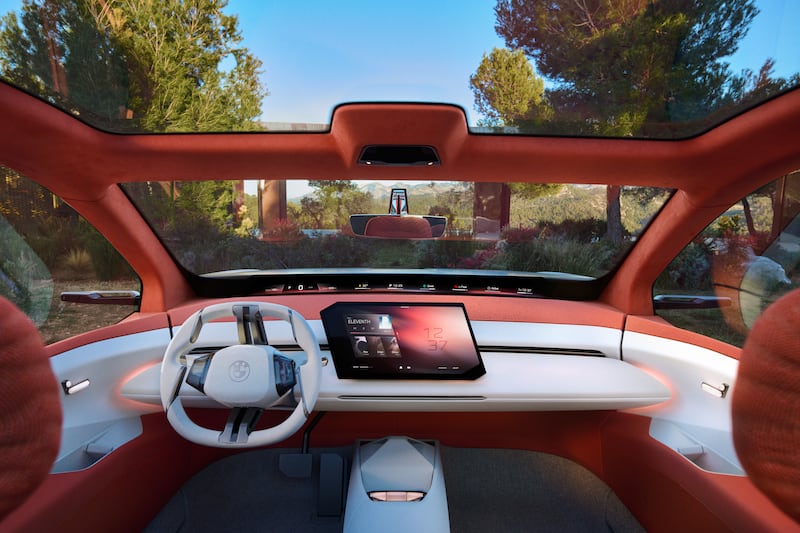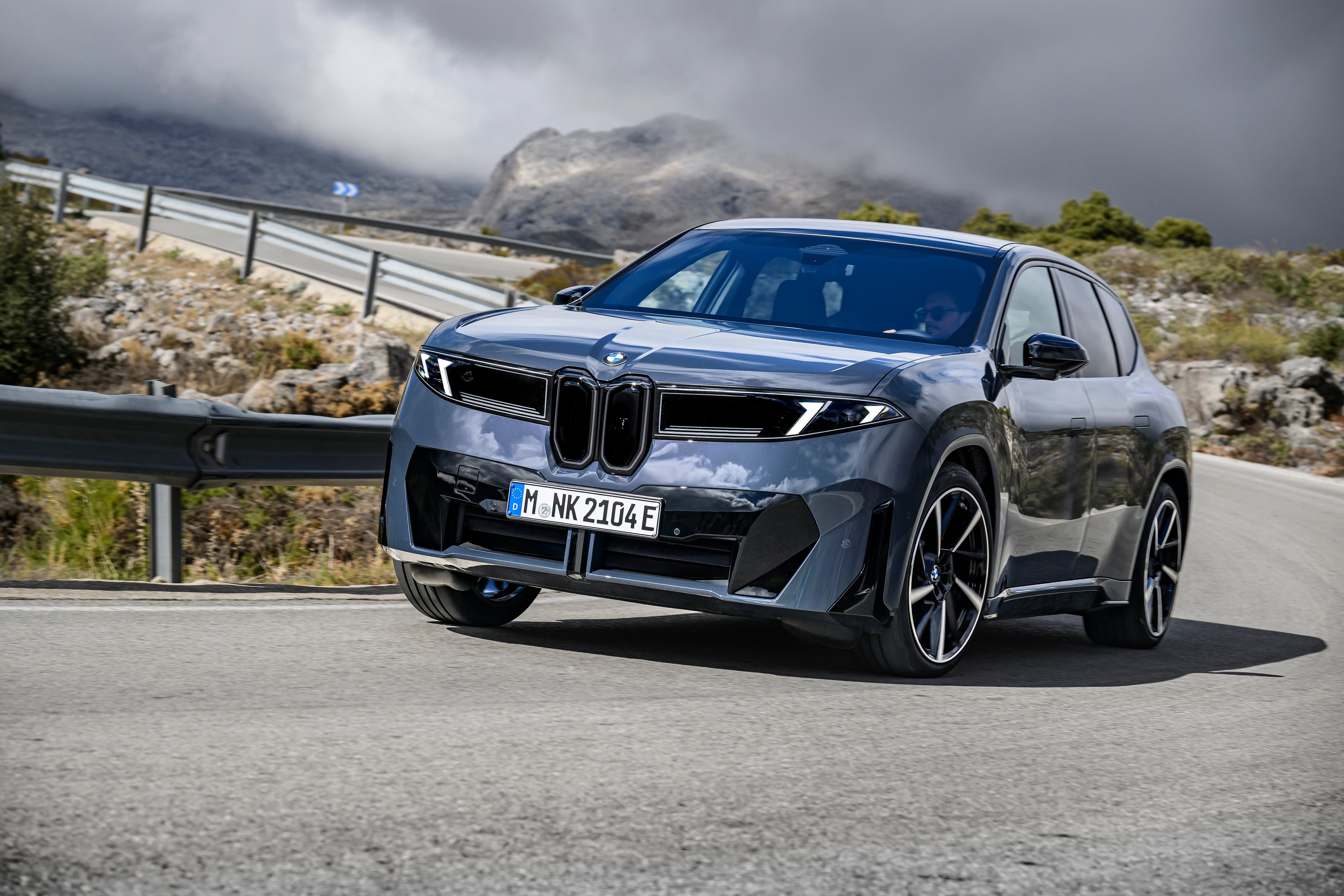You would need considerable chutzpah to try to defend the styling choice that is the huge, honking grille of the electric BMW iX SUV, but Kai Langer is just that person. He tries to convince me of the rightness of the design, and it’s nothing to do with Chinese customers preferring bigger, brasher grilles.
“Honestly, this grille was the best solution,” he says. “Because it’s not a grille at all: it’s a panel for the forward-facing sensors for all the safety systems. So it needs to be the right size, it needs to be made of the right material – because metal parts can block radar signals – and it needs to not be affected by weather. So this really was the best way to do it.”
Langer, with his loose-fitting jumper and tousled hair, is irrepressibly enthusiastic, and all the more so when talk turns to classic BMWs such as the E30 3 Series Touring. Perhaps that shouldn’t come as much of a surprise, because it was Langer’s job, as head of BMW’s i-car design team, to come up with a new look for the German brand’s all-electric next-generation SUV, and he has definitely chosen a 1980s vibe for this new car.
This is the BMW Vision Neue Klasse X, a slightly torturous name that means it’s still a concept car (the Vision part), and that it’s designed around the same all-electric platform as the sleek and sharp Neue Klasse saloon concept, while the X bit means that it’s an SUV, and part of the huge-selling BMW X model line-up, which began with the original X5 in 1999. Twelve million sales on, the electric revolution within the X line-up is speeding up.
READ MORE
You can instantly see the family resemblance to the 3 Series-sized Neue Klasse saloon concept in the X’s clean, uncluttered lines, its minimalist panel work and the broad, slim, LED light panels at the front, which form both the headlights and a kind of grille effect that thankfully (sorry, Langer) moves us away from the big, tall, narrow grille look of the iX and i4.
For what it’s worth, the digital dashboard of this concept version showed a 600km range on a full charge, compared with the claimed 470km of an iX3 (which is much closer to 400km of actual useable range)
However, there’s a distinct difference here, as the X includes a pair of traditional BMW kidney grilles set in the centre of the Neue Klasse X’s front fascia, a look that will not be shared with the saloon version. Why? “We needed a new interpretation of BMW’s design language,” says Langer. “Back in 1961, with the original Neue Klasse 1500, we introduced an entirely new type of vehicle: the dynamic midsize saloon. This Neue Klasse X is a dynamic athlete for our modern X range, just like that 1500 was. It shows how we are going to change the look and feel of the BMW brand, and we wanted to create a more distinctive, horizontal look for the sedan models. For the X models, we wanted to give them a more imposing look, but without building them up so high, because that’s bad for efficiency.”
Obviously, there’s many a slip between concept show star cup and dealership lip, but Langer says that the looks of the Neue Klasse X are about 80 per cent the finished item, which will go on sale in 2025, actually beating the Neue Klasse saloon into production.
As with the saloon, BMW is claiming big improvements in battery performance and overall efficiency for the Neue Klasse X. The new battery pack is claimed to be 20 per cent more energy-dense than that of the current BMW iX3 (which the Neue Klasse X will effectively replace), allowing a 30 per cent improvement in range and energy efficiency. For what it’s worth, the digital dashboard of this concept version showed a 600km range on a full charge, compared with the claimed 470km of an iX3 (which is much closer to 400km of actual usable range).
The X also represents a step-change in the overall efficiency of a midsize SUV. Compared with the iX3, when production begins at the Debrecen factory in Hungary next year, the Neue Klasse X will have an overall CO2 footprint that is claimed to be 25 per cent smaller, while BMW is looking to achieve a 40 per cent carbon emissions reduction in the overall supply chain. Added to which is a boost in the use of recycled materials to 35 per cent of the vehicle’s overall content.

Inside, the cabin represents a turnaround from the traditional dark and enclosing BMW interiors. The overall look is far lighter and more welcoming, with oatmeal-coloured seat trim and orange highlights giving a slightly 1970s look. Hopefully BMW can keep this concept’s low shoulder-line and expansive windows, as they make the interior seem far more light, bright and pleasant than anything the company is making today.
The windscreen incorporates a vast side-to-side display screen, called the Panoramic Vision Screen. This screen does away with the driver’s digital instrument panel, and is a sort of combined head-up display and full-width instrument screen. It interconnects with the large, rhombus-shaped central infotainment screen, and you can click and swipe icons, functions and displays between the two screens with ease.
BMW’s head of UX and UI software design, Reihard Seydel, says the Neue Klasse’s digital systems have been designed after an exhaustive consultation with 2,000 customers, and drawing on data from 10 million connected BMW models. He describes the system as “a quantum leap” and there are claims that it will “reshape the driving experience for everyone on board. Not just the driver – everyone.”
There are some neat novelty functions for the driver, including the HypersonX Wheel, which allows you to change and tune the driving sounds the Neue Klasse X projects into the cabin, but behind such fripperies, more serious work is going on.
The whole digital set-up has been designed around a “hands on wheel, eyes on road” set-up (thankfully, BMW continues to resist daft Tesla-style claims of “full self-driving”) and the screens, lighting and sound system have been designed to use “multi-modal dialogue”, including colours, sounds and on-screen images, to keep the driver informed as to what is going on around them. Often such systems – and their partners in lane-keeping steering and adaptive cruise control – can prove more distracting and irritating than they ought to be, but BMW claims this system has been designed so that you won’t want to switch it off.
[ What is the point of the BMW X2′s existence?Opens in new window ]
A big part of that involves the behind-the-scenes electronic work, which the company says is “revolutionary” and chops the number of individual electronic control units installed around the car – which can number more than 20 in some current vehicles – to just two. One of those, cringingly called The Heart of Joy, controls manual driving systems, while the other looks after automated driver aids. These on-board computers are said to be up to 10 times faster than previous versions, and they’re not just designed by egghead software engineers; BMW’s expert driver training team was brought in to help develop the new systems from the ground up.
Quite apart from anything else, the reduction of multiple ECUs means there’s a considerable weight saving of some 30 per cent in the car’s internal wiring. The idea is that every single press of the accelerator and twitch of the steering wheel doesn’t just alter what the electric motors or the steering rack are up to, but they will also alert a whole hive of interconnected subsystems, all of which are said to improve your driving pleasure.
Indeed, Alexander Karajlovic, head of the driving experience programme for the Neue Klasse vehicles, says: “This is going to be a new dimension of ‘Sheer Driving Pleasure’, and the Neue Klasse will totally reshape this concept. Sheer Driving Pleasure was born with the original Neue Klasse 1500 in 1961 – it was sporty, comfortable, safe and positive – and it created an indelible connection between the car and the driver. Our engineers have developed systems that put people at the centre. These systems provide a complete interpretation of longitudinal and lateral dynamic forces in a central, digital platform which we make entirely in-house.”
Tantalisingly, for potential future high-performance M-Sport models, Karajlovic confirmed that the Neue Klasse system have been set up to work with as many as four electric motors at once.
- Listen to our Inside Politics Podcast for the latest analysis and chat
- Sign up for push alerts and have the best news, analysis and comment delivered directly to your phone
- Find The Irish Times on WhatsApp and stay up to date





















